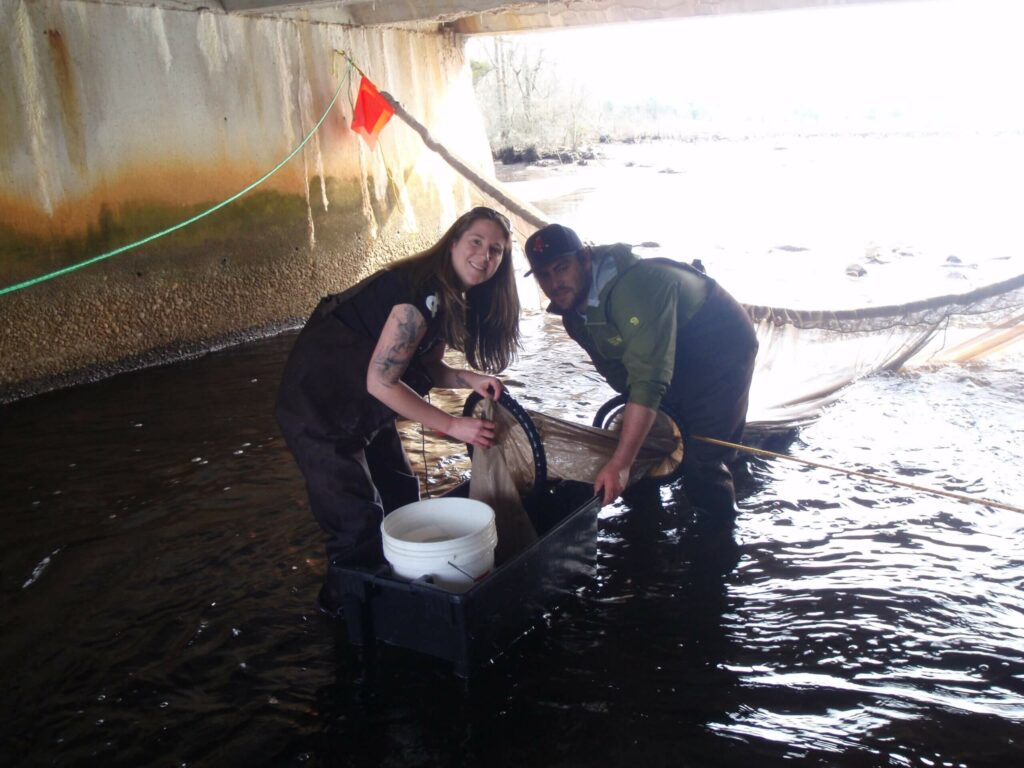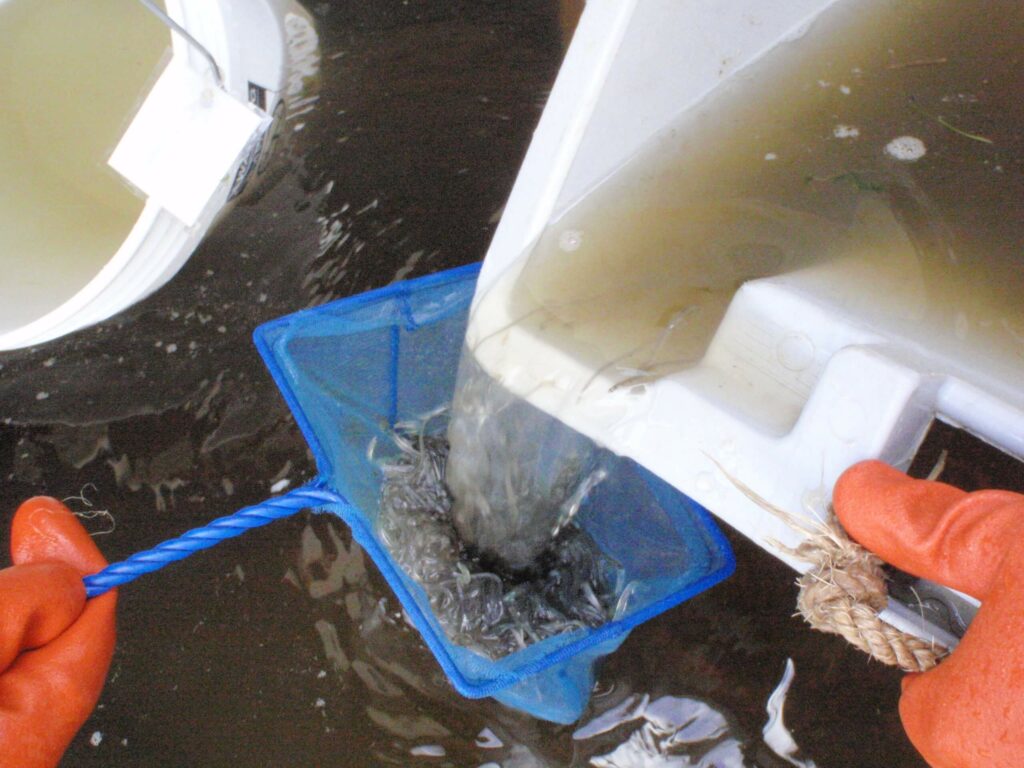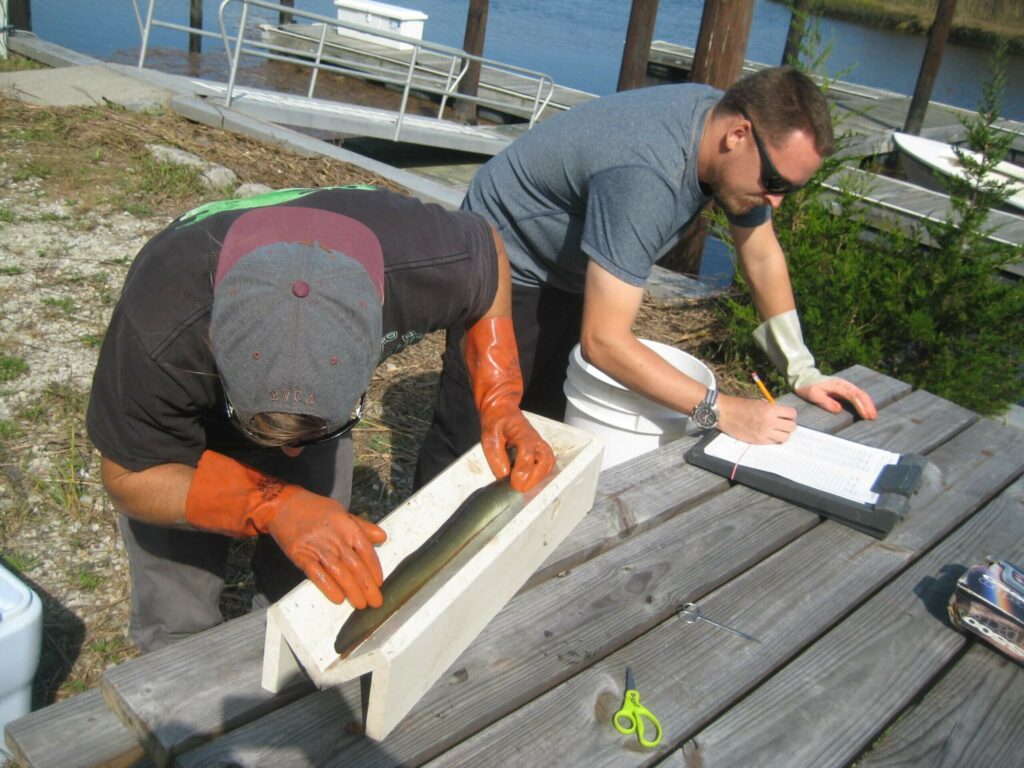
The American Eel Young-of-Year (glass eel) Survey is a fishery-independent monitoring project required by the Interstate Fisheries Management Plan (FMP) for American Eel. In accordance with the FMP, the Bureau of Marine Fisheries is required to conduct a survey for American eel at one location in New Jersey to provide an annual juvenile abundance index. The fyke net survey was developed in 1999 to develop such an index for this species, reported as the number of glass eels per haul (geometric mean). Alternative collectors for glass eels were developed in 2012 to sample various locations in conjunction with the fyke net.
In response to the 2010 Atlantic States Marine Fisheries Commission’s (ASMFC) Stock Assessment of American Eel indicating a depleted stock status, New Jersey developed and implemented a fishery-independent survey targeting yellow eels in 2015. The purpose of the Yellow Eel Survey is to collect abundance data of yellow American eels within nursery grounds. This survey supplements the current glass eel survey by sampling additional life stages, determining suitable adult habitats and allowing biologists to collect biological samples. The survey provides seasonal (spring and fall) and annual abundance indices for yellow American eels, reported as the number of yellow eels per haul (geometric mean). While this survey is not a requirement of the FMP for American Eel, it provides valuable life cycle information that is currently lacking coastwide.
Data collected from both surveys is highly beneficial to American eel population studies. Not only do these surveys tell us how many fish are present from year to year, but the data also contributes to the development of fisheries management plans and projections of sustainable harvest levels.
These surveys target American eels at various life stages: glass eels, green eels and yellow eels. American eels are found from Greenland to Florida and the Gulf of Mexico. The species’ population is regarded as a single breeding population. They can be found in a variety of habitats throughout their life cycle, including the open ocean, large coastal tributaries, small freshwater streams, lakes and ponds. They are opportunistic feeders that eat phytoplankton, zooplankton, insects, crustaceans and fish. Life begins in the Sargasso Sea. Larvae (leptocephali) and juveniles migrate towards the coast during their first year of life, in search of freshwater habitats. Glass eels mature in freshwater or estuarine environments as they pass through the green and yellow eel life stages. American eels are often used as a water quality and pollution indicator because they remain in the same habitat for such a long portion of their lives. After anywhere from 3 to 30 or more years, adult American eels mature into silver eels and return to the Sargasso Sea to spawn and die.
Several South Jersey sites were scouted as possible locations to set the fyke net. The location sampled annually is located within the Great Egg Harbor estuary. The alternative collector portion of the survey consists of one collector set in the Great Bay estuary. A second collector is often set prior to the fyke net to monitor the start of the seasonal migration.
Great Bay was chosen as the sampling location for the yellow eel pot survey. Since glass eel data was already being collected from this estuary, it was safe to assume that Great Bay would be an ideal location to find yellow eels. A grid system was used to create a series of sampling locations. A randomized list of those stations was developed to determine the order of sampling each season. Four different locations are sampled each week.

The glass eel survey utilizes a modified Japanese style fyke net made from 1/32-inch mesh, with two wings which funnel the catch into the cod end of the net. The net is set across the entire width of an underpass at the head of a tidal stream. Floats are attached to the top of the net and weights are added to the bottom, to allow maximum fishing at high tide. The size, shape and materials of the net have not changed since the survey’s inception.

Alternative glass eel collectors were constructed by attaching frayed polypropylene rope to a PVC planter base with cable ties. Each collector is weighed down by attaching a terracotta base to the bottom of the PVC planter. The collectors are “seasoned” in brackish water for two months prior to use to eliminate any artificial odor and to allow algae, fish and other species to utilize them as a temporary habitat. These collectors are used to collect abundance data in streams and rivers outside of the fyke net location.

Commercial eel pots were purchased for the yellow eel pot survey and rigged into strings of four pots each. The commercial-style cylindrical pots are made from plastic coated metal mesh. The mesh is 5/8-inch square, with a 2.25-inch square panel on one end which allows fish to enter the pot. The vessel used during this survey is a 20-foot May Craft Cape Classic with a 150-horsepower Evinrude E-TEC 2-stroke outboard engine.
The FMP for American Eel requires six weeks of sampling during the peak ingress of glass eels. In New Jersey, this typically begins during the month of February. Both the fyke net and the collectors are tended daily, seven days a week, at the daylight low tide. When weather or crew restrictions occur, the net is pulled from the water or tied up so that it’s not fishing. An alternate collector may remain in the water without being checked daily, if necessary. The sampling season ends when a minimum of six weeks of fyke net sampling are complete and catch numbers are at or near zero each day.
Through an analysis of commercial American eel data, it was determined that yellow eel sampling would occur during spring and fall, when catches are at their highest. The survey is conducted for eight weeks each spring (mid-April to mid-June) and fall (mid-September to mid-November).
Start and end dates for both surveys are determined based on environmental and weather conditions in the area.

The total number of glass eels caught in the fyke net is calculated daily. A subsample of 60 glass eels from the fyke net are individually weighed, measured and checked for pigmentation stage at least twice a week. No individual lengths or weights are recorded from glass eels caught in the collectors, but a total count is recorded. All green eels caught in the fyke net are individually weighed and measured, while those caught in the collectors are simply counted. All eels caught during this survey are released alive at the location where they were caught.

Sampling crews collect and record environmental parameters each time the fyke net and collectors are tended: water temperature, air temperature, pH, wind speed and direction, as well as water depth.
During the yellow eel pot survey, four strings of four pots each are set at predetermined locations on Monday, tended and reset on Wednesday and tended and pulled on Friday. Pots are baited with Atlantic menhaden (bunker). Soak times are weather dependent and range from 12-48 hours. Various environmental and climatological data are recorded when pots are set and again when pots are tended: water depth, air temperature, dissolved oxygen, water temperature, salinity and pH. Each time a string of pots is hauled in, the total number of eels caught is recorded.
Lengths and weights are collected from each yellow eel caught in the pot survey. Additionally, a small notch (fin clipping) is cut into the pectoral fin of each eel in an effort to monitor recaptures. The eels are released alive; however, a subsample is retained for additional biological sampling which involves removing the otoliths for age data. Otoliths are part of the inner ear of the eel and can be aged by counting their rings, like ageing a tree. Because this survey utilizes commercial gear in a commercially important estuary, age data collected during the yellow eel pot survey supplements the American eel biological sampling program of the commercial fishery (fishery-dependent).
Bycatch from both surveys is identified by species, counted and released.

The total number of glass eels caught during the fyke net survey fluctuates annually. Timing and rate of the annual ingress from saltwater to freshwater is dependent on many factors that vary greatly from year to year or even week to week. Ocean temperature, currents, wind rates and direction, air temperature, coastal flooding patterns and winter storm occurrence and intensity are some of the most common influences on glass eel recruitment into New Jersey waters. Winters with above average air temperatures produce an early increase in coastal water temperatures. This typically means that glass eels will begin to arrive earlier in the year while the water is still colder. As water temperatures increase, the number of glass eels moving into freshwater rivers and streams tends to decrease. Flooding and drought incidents or ice coverage can also alter the course that glass eels choose to take into freshwater. These environmental influences alter the salinity of coastal waters. When there is an influx of freshwater from rain or snowstorms, the salinity of coastal rivers and streams goes down. Conversely, when there are periods of drought conditions with little freshwater runoff, the salinity of those water bodies goes up. Since glass eels are looking to move from saltwater into freshwater during the winter months, slight changes in salinity can alter their movements and the timing of those actions. Correlations between the lunar cycle and migration patterns are well documented and can also affect the ingress of glass eels. Some of the highest catches during the fyke net survey occur during the new or full moon. In summary, a multitude of factors alter the number of glass eels moving through the sampling locations on an annual basis.
Glass eels collected during the fyke net survey are subsampled for biological data including lengths and weights. On average, the eels sampled are 2.5 inches long and weigh a mere 0.2 grams (0.0004 pounds). Pigmentation stages are also recorded for all eels in the subsample. Glass eels are clear fish, hence the name. As they age, their bodies become pigmented in stages (1-7). Stage 1 is clear while stage 7 is the darkest and at that point they are considered a green eel. The average pigmentation of a glass eel caught in the fyke net is stage 2.
The number of glass eels collected in an artificial collector is subject to the same environmental influences as the fyke net and varies from year to year. In 2012, biologists were surprised by one single catch of over 31,000 eels in one collector! These artificial collectors have proven to be a reasonable representation of the type of structure that glass eels want to inhabit. The success of this portion of the glass eel survey has led to a long-anticipated expansion of the project which will include collecting biological data from individual eels, as opposed to just a total count of the number of eels caught in each collector.
American eels will remain in freshwater or brackish water until they reach the silver life stage and return to the ocean. The Great Bay’s abundance of small fish, insects and mollusks makes this estuary an excellent home for yellow eels. It is at this life stage that eels are commonly used as fishing bait. Since its inception in 2015, the yellow eel pot survey has collected larger catches during fall sampling each year. As water temperature increases, catch totals often decrease. Yellow eels tend to be most abundant in Great Bay when the water temperature is between 54-73 degrees Fahrenheit. While survey catches within the Great Bay vary from year to year, American eels are consistently present within the estuary, and this remains a positive sign that eels continue to endure at a local location once they’ve entered Jersey waters.

All American eels caught during the pot survey are weighed and measured. On average, the yellow eels sampled are 19 inches long and weigh 0.5 pounds. Additionally, age data is collected from a subsample of eels caught during the pot survey. Most yellow eels caught during the survey are between three and five years old, with an average age of 4.5 years old. Over the next few years, this survey will be expanded to include tagging eels with Passive Integrated Transponder (PIT) tags to collect recapture data. PIT tags are small microchips which are implanted safely in many species of animals. Each tag has a unique code associated with it. When a tagged animal is caught, the chip can be scanned to retrieve the code and biologists can determine when and where the animal was originally tagged. Length and weight measurements taken at the time of recapture are compared to initial measurements. This allows biologists to track the growth rates of the tagged species. Studying the movement patterns and growth rates of American eels is a vital part of assessing the stock within New Jersey. Additional data to be collected within the next few years include gender and presence/absence of a swim bladder nematode, Anguillicola crassus. This type of parasitic worm is common throughout the population of American eels. A healthy swim bladder is necessary to survive the exhausting migration back to the Sargasso Sea that can be thousands of miles long and take months to complete. Knowing how many eels are affected by this parasite could potentially help biologists determine how much influence their presence has on swim bladder functions and survival rates of American eels.
All life stages of American eels are subject to fishing pressure. Surveys like the ones conducted by New Jersey’s Bureau of Marine Fisheries allow biologists to learn more about the impact that recreational and commercial fishing has on New Jersey’s local eel population. Data collected from abundance surveys such as the glass and yellow eel surveys are key elements of Coastwide stock assessments. There are very few fishery-independent surveys that target American eel along the East Coast of the United States, so it is important for New Jersey to continue and expand current research on various life stages. American eels are found in marine, estuarine and freshwater habitats. Learning more about habitat requirements that allow eels to progress through all life stages successfully and return to the Sargasso Sea to spawn is critical.
While the ASMFC’s 2012 Benchmark Stock Assessment and the 2017 Update Assessment state that the American eel population is depleted, New Jersey has not seen a major decrease in the number of eels caught in either the glass or yellow eel survey. Hopefully this trend will continue, paving the way for a more robust Coastwide population in the future.
Additional Information on Species
Project Lead Contact Information/Designated Contact Person
Jennifer Pyle, Fisheries Biologist
Jennifer.Pyle@dep.nj.gov
609-748-2020
Partners/Funding
Funding for the glass eel survey is supported by the federal Sport Fish Restoration Program administered by the U.S. Fish & Wildlife Service.
Funding for the yellow eel pot survey is provided by the Atlantic Coastal Fisheries Cooperative Management Act supported by the National Oceanic and Atmospheric Administration’s National Marine Fisheries Service (NOAA Fisheries) in cooperation with the U.S. Fish & Wildlife Service.
 Official Site of The State of New Jersey
Official Site of The State of New Jersey

